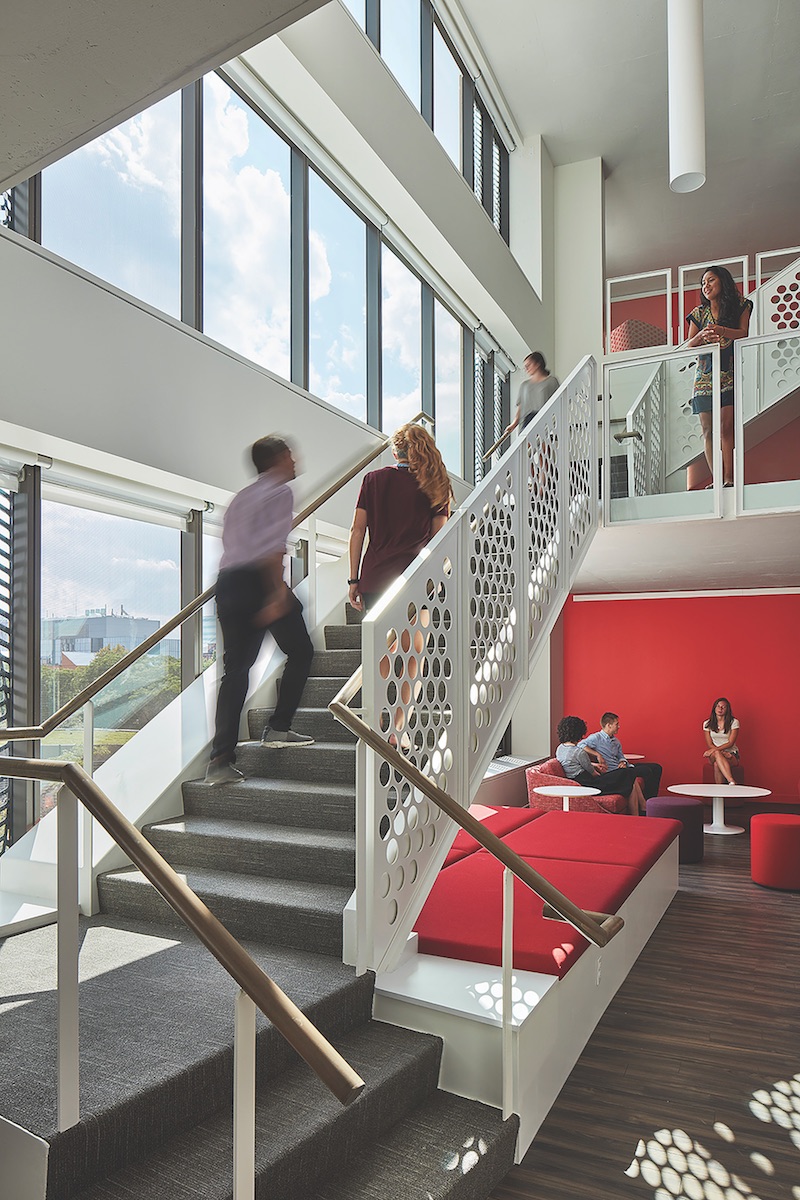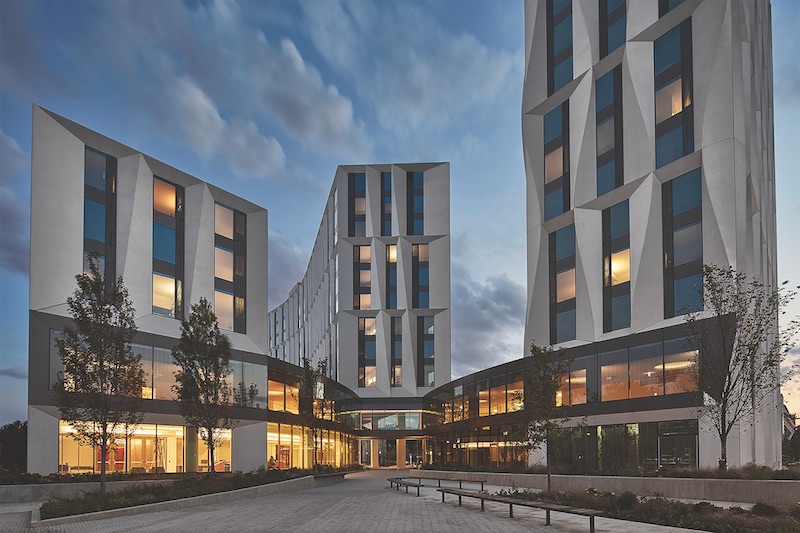The new North Residential Commons on the University of Chicago campus is more than just a place for students to eat and sleep when they aren’t in class or studying. The 400,000-sf residence hall offers students a place to live that blurs the lines between a campus and a community.
Plazas, gardens, walkways, and courtyards connect four separate buildings that range from one to 15 floors. A single-story dining hall, equipped with floor-to-ceiling windows for abundant natural light, overlooks a central quad.
Eight “houses” accommodate 800 undergraduate students. Each house has its own hub, a three-story common area where students can gather, study, and relax. Also included are classrooms, music practice rooms, and 10,000 sf of ground-level retail space. A reading room resides on the top floor and offers views of the city and Lake Michigan.
 An example of one of the three-story hubs. These hubs can be used by the students for anything ranging from studying to relaxing. Tom Harris Photography.
An example of one of the three-story hubs. These hubs can be used by the students for anything ranging from studying to relaxing. Tom Harris Photography.
The Building Team used BIM to simplify the project’s complex geometry. Through the use of the model, the team was able to determine that the original knife-shaped edges of the exterior precast panels needed minor adjustments. The edges were susceptible to chipping, so the top edge of the panels was changed to a more blunt-shaped edge.
The building was designed to reflect the university’s distinctive housing system, where students of all years live and work together to achieve a higher level of social and academic success.
“More effective than the design was the extraordinary effort to meet the owner’s and users’ needs,” said Building Team Awards judge Peter Isaac, Vice President with Brailsford & Dunlavey, and a BD+C 2016 40 Under 40 honoree. “It is clear the Building Team worked in close coordination with the University of Chicago.”
Building Team – Submitting firm, general contractor Mortenson Construction Owner University of Chicago Architect Studio Gang Architects Structural engineer Magnusson Klemencic Associates Mechanical engineer dbHMS
General Information – Size 394,020 sf Cost $161 million Construction time July 2014 to September 2016 Delivery method Design-build
Related Stories
Higher Education | Aug 22, 2023
How boldly uniting divergent disciplines boosts students’ career viability
CannonDesign's Charles Smith and Patricia Bou argue that spaces designed for interdisciplinary learning will help fuel a strong, resilient generation of students in an ever-changing economy.
Higher Education | Aug 7, 2023
Building a better academic workplace
Gensler's David Craig and Melany Park show how agile, efficient workplaces bring university faculty and staff closer together while supporting individual needs.
University Buildings | Aug 7, 2023
Eight-story Vancouver Community College building dedicated to clean energy, electric vehicle education
The Centre for Clean Energy and Automotive Innovation, to be designed by Stantec, will house classrooms, labs, a library and learning center, an Indigenous gathering space, administrative offices, and multiple collaborative learning spaces.
Market Data | Aug 1, 2023
Nonresidential construction spending increases slightly in June
National nonresidential construction spending increased 0.1% in June, according to an Associated Builders and Contractors analysis of data published today by the U.S. Census Bureau. Spending is up 18% over the past 12 months. On a seasonally adjusted annualized basis, nonresidential spending totaled $1.07 trillion in June.
Market Data | Jul 24, 2023
Leading economists call for 2% increase in building construction spending in 2024
Following a 19.7% surge in spending for commercial, institutional, and industrial buildings in 2023, leading construction industry economists expect spending growth to come back to earth in 2024, according to the July 2023 AIA Consensus Construction Forecast Panel.
Mass Timber | Jul 11, 2023
5 solutions to acoustic issues in mass timber buildings
For all its advantages, mass timber also has a less-heralded quality: its acoustic challenges. Exposed wood ceilings and floors have led to issues with excessive noise. Mass timber experts offer practical solutions to the top five acoustic issues in mass timber buildings.
Adaptive Reuse | Jul 6, 2023
The responsibility of adapting historic university buildings
Shepley Bulfinch's David Whitehill, AIA, believes the adaptive reuse of historic university buildings is not a matter of sentimentality but of practicality, progress, and preservation.
University Buildings | Jun 26, 2023
Univ. of Calif. Riverside’s plant research facility enables year-round plant growth
The University of California, Riverside’s new plant research facility, a state-of-the-art greenhouse with best-in-class research and climate control technologies, recently held its grand opening. Construction of the two-story, 30,000 sf facility was completed in 2021. It then went through two years of preparation and testing.
University Buildings | Jun 26, 2023
Addition by subtraction: The value of open space on higher education campuses
Creating a meaningful academic and student life experience on university and college campuses does not always mean adding a new building. A new or resurrected campus quad, recreational fields, gardens, and other greenspaces can tie a campus together, writes Sean Rosebrugh, AIA, LEED AP, HMC Architects' Higher Education Practice Leader.
Engineers | Jun 14, 2023
The high cost of low maintenance
Walter P Moore’s Javier Balma, PhD, PE, SE, and Webb Wright, PE, identify the primary causes of engineering failures, define proactive versus reactive maintenance, recognize the reasons for deferred maintenance, and identify the financial and safety risks related to deferred maintenance.

















